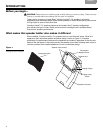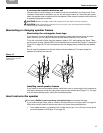
11
S
TEPS TO INSTALLING
English Français NederlandsDeutsch Italiano
Testing the space behind the hole
7LSYou need a tape measure and a sturdy wire (such as a straightened coat hanger)
22 in. (55.9 cm) in length for this step.
1. Bend the wire as shown in Figure 10.
Figure 10
A 22-inch (55.9 cm) length
of sturdy wire bent in two
places
14
1
/
4
in.
(36.2 cm)
4
3
/
4
in.
(12 cm)
3 in. (7.6 cm)
4
1
/
8
in.
(10.5 cm)
7LSFor greater accuracy, make the first bend a little long, measure again, and cut off the extra
length at that end.
WARNING:
If there is any possibility of electrical wiring in the space behind the wallboard, wrap
the wire with electrical tape to prevent electric shock.
2. Make a mark 4
1
/
8
in. (10.5 cm) from the short end as an indicator of the proper
front-to-back depth of the hole.
3. Use the bent wire to test for enough depth, front-to-back:
Insert the short end of the wire into the hole and straight back (Figure 11). Probe to make
sure nothing is in the way to a depth of 4
1
/
8
in. (10.5 cm). This indicates that the space
behind the wallboard is deep enough for the front-to-back speaker dimension.
Figure 11
Checking the space for the
depth of the speaker
4
1
/
8
"
(
1
0
.
5
c
m
)
4
1
/
8
"
(
1
0
.
5
c
m
)
• If the wire goes in without a problem, proceed to step 4, below.
• If you cannot insert the wire to the 4
1
/
8
-inch (10.5 cm) mark, you need to drill a new pilot
hole elsewhere. Then repeat step 3.
4. Use the wire again to test the width, side-to-side:
With the short end still in the hole, reposition it, as shown in Figure 12 on page 12, and
rotate it 360° around the hole. This indicates if the wall space is wide enough on each
side of the hole for the side-to-side dimension of the speaker.


















